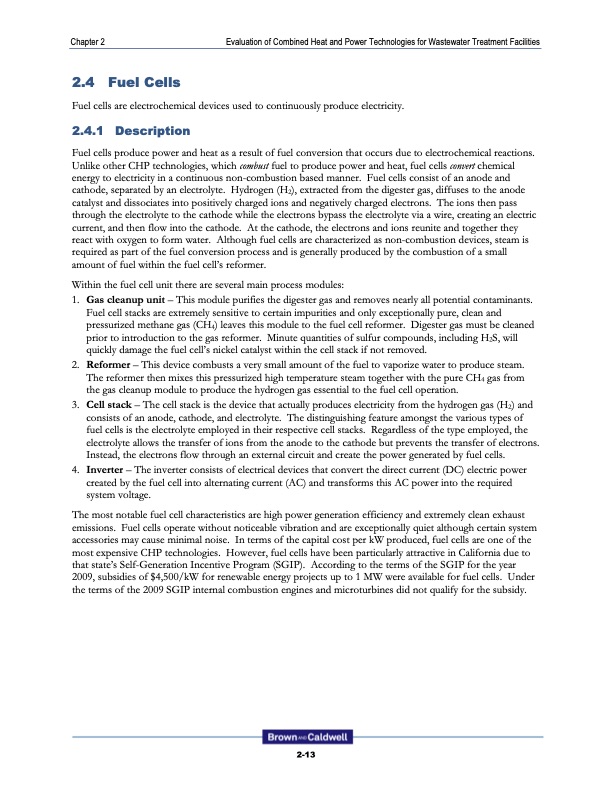
PDF Publication Title:
Text from PDF Page: 038
Chapter 2 Evaluation of Combined Heat and Power Technologies for Wastewater Treatment Facilities 2.4 Fuel Cells Fuel cells are electrochemical devices used to continuously produce electricity. 2.4.1 Description Fuel cells produce power and heat as a result of fuel conversion that occurs due to electrochemical reactions. Unlike other CHP technologies, which combust fuel to produce power and heat, fuel cells convert chemical energy to electricity in a continuous non-combustion based manner. Fuel cells consist of an anode and cathode, separated by an electrolyte. Hydrogen (H2), extracted from the digester gas, diffuses to the anode catalyst and dissociates into positively charged ions and negatively charged electrons. The ions then pass through the electrolyte to the cathode while the electrons bypass the electrolyte via a wire, creating an electric current, and then flow into the cathode. At the cathode, the electrons and ions reunite and together they react with oxygen to form water. Although fuel cells are characterized as non-combustion devices, steam is required as part of the fuel conversion process and is generally produced by the combustion of a small amount of fuel within the fuel cell’s reformer. Within the fuel cell unit there are several main process modules: 1. Gascleanupunit–Thismodulepurifiesthedigestergasandremovesnearlyallpotentialcontaminants. Fuel cell stacks are extremely sensitive to certain impurities and only exceptionally pure, clean and pressurized methane gas (CH4) leaves this module to the fuel cell reformer. Digester gas must be cleaned prior to introduction to the gas reformer. Minute quantities of sulfur compounds, including H2S, will quickly damage the fuel cell’s nickel catalyst within the cell stack if not removed. 2. Reformer–Thisdevicecombustsaverysmallamountofthefueltovaporizewatertoproducesteam. The reformer then mixes this pressurized high temperature steam together with the pure CH4 gas from the gas cleanup module to produce the hydrogen gas essential to the fuel cell operation. 3. Cellstack–Thecellstackisthedevicethatactuallyproduceselectricityfromthehydrogengas(H2)and consists of an anode, cathode, and electrolyte. The distinguishing feature amongst the various types of fuel cells is the electrolyte employed in their respective cell stacks. Regardless of the type employed, the electrolyte allows the transfer of ions from the anode to the cathode but prevents the transfer of electrons. Instead, the electrons flow through an external circuit and create the power generated by fuel cells. 4. Inverter–Theinverterconsistsofelectricaldevicesthatconvertthedirectcurrent(DC)electricpower created by the fuel cell into alternating current (AC) and transforms this AC power into the required system voltage. The most notable fuel cell characteristics are high power generation efficiency and extremely clean exhaust emissions. Fuel cells operate without noticeable vibration and are exceptionally quiet although certain system accessories may cause minimal noise. In terms of the capital cost per kW produced, fuel cells are one of the most expensive CHP technologies. However, fuel cells have been particularly attractive in California due to that state’s Self-Generation Incentive Program (SGIP). According to the terms of the SGIP for the year 2009, subsidies of $4,500/kW for renewable energy projects up to 1 MW were available for fuel cells. Under the terms of the 2009 SGIP internal combustion engines and microturbines did not qualify for the subsidy. 2-13PDF Image | Combined Heat and Power Technologies for Wastewater Facilities

PDF Search Title:
Combined Heat and Power Technologies for Wastewater FacilitiesOriginal File Name Searched:
300_CHP-EPA-w-Apps.pdfDIY PDF Search: Google It | Yahoo | Bing
Capstone Turbine and Microturbine: Capstone microturbines used and new surplus for sale listing More Info
Consulting and Strategy Services: Need help with Capstone Turbine, sizing systems, applications, or renewable energy strategy, we are here to assist More Info
Container Lumber Dry Kiln: Since 1991 developing and innovating dry kilns using standard shipping containers More Info
Supercritical CO2 Lumber Dry Kiln: Compact fast drying in 3 days or less for small amounts of wood and lumber drying More Info
BitCoin Mining: Bitcoin Mining and Cryptocurrency... More Info
Publications: Capstone Turbine publications for microturbine and distributed energy More Info
FileMaker Software for Renewable Energy Developing database software for the renewable energy industry More Info
CO2 Gas to Liquids On-Demand Production Cart Developing a supercritical CO2 to alcohol on-demand production system (via Nafion reverse fuel cell) More Info
Stranded Gas for low cost power Bitcoin Mining Using stranded gas for generators may provide breakthrough low power costs for cryptocurrency miners. More Info
| CONTACT TEL: 608-238-6001 Email: greg@globalmicroturbine.com | RSS | AMP |